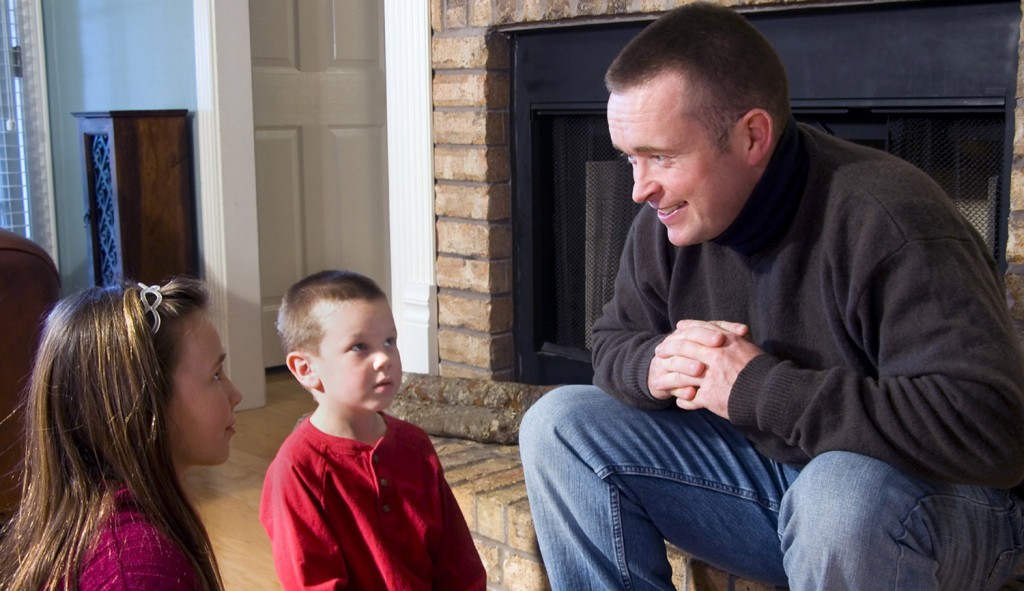
Parenting  You may be tempted to do a complete overhaul of how things go around your home. That temptation can be stronger if you're going through a difficult time with your little one, like the Terrible Twos, or if you have teenagers who seem to break every rule. But putting too many rules in place all at once when they weren’t there before makes it harder to follow through. If your child has a developmental problem where routine is important, it may even cause a backlash that worsens existing problems.
When you're imposing rules, start small and be very clear. Give children time to adjust to each rule, only setting a new one once everyone is comfortable with the old one.
You may be tempted to do a complete overhaul of how things go around your home. That temptation can be stronger if you're going through a difficult time with your little one, like the Terrible Twos, or if you have teenagers who seem to break every rule. But putting too many rules in place all at once when they weren’t there before makes it harder to follow through. If your child has a developmental problem where routine is important, it may even cause a backlash that worsens existing problems.
When you're imposing rules, start small and be very clear. Give children time to adjust to each rule, only setting a new one once everyone is comfortable with the old one.
 When you set limitations and boundaries, you're inevitably going to consider consequences. As children and teens cross boundaries, break rules, and make mistakes, it's important that they experience natural consequences so they learn for themselves that golden word "responsibility." Responsibility is not something that can be forced. It has to be learned by recognizing the consequences of one's actions and deciding to either accept or avoid them.
Toddlers can learn that if they throw their cup onto the floor, it won't be coming back. Teens can learn that when they misuse or damage their things, they will have to replace those items. This teaches them the value of their possessions and that if they care for those things, they won't be lost. This idea can be adapted to fit the needs of your child. Be realistic in your goals according to your child's abilities.
Note that for natural consequence to work, Mom and Dad have to resist the urge to make things all better. No retrieving the cup from the floor, and no paying for broken items. This may be the hardest part of setting limits for some parents.
When you set limitations and boundaries, you're inevitably going to consider consequences. As children and teens cross boundaries, break rules, and make mistakes, it's important that they experience natural consequences so they learn for themselves that golden word "responsibility." Responsibility is not something that can be forced. It has to be learned by recognizing the consequences of one's actions and deciding to either accept or avoid them.
Toddlers can learn that if they throw their cup onto the floor, it won't be coming back. Teens can learn that when they misuse or damage their things, they will have to replace those items. This teaches them the value of their possessions and that if they care for those things, they won't be lost. This idea can be adapted to fit the needs of your child. Be realistic in your goals according to your child's abilities.
Note that for natural consequence to work, Mom and Dad have to resist the urge to make things all better. No retrieving the cup from the floor, and no paying for broken items. This may be the hardest part of setting limits for some parents.
 It can be so hard to remain firm, especially when your child breaks a rule he or she knows is in place. But consistency is a necessary part of child-rearing, especially when teaching important boundaries that will be carried on later in life. If your child breaks a rule, you have to stick with it and deliver the consequences you said you would.
Of course, that doesn’t mean you have to be harsh. Often just sitting your child down and explaining why there will be a consequence can be even more effective than the punishment itself. After all, some rebellion is a natural part of your child growing up. It is also an opportunity for learning.
It can be so hard to remain firm, especially when your child breaks a rule he or she knows is in place. But consistency is a necessary part of child-rearing, especially when teaching important boundaries that will be carried on later in life. If your child breaks a rule, you have to stick with it and deliver the consequences you said you would.
Of course, that doesn’t mean you have to be harsh. Often just sitting your child down and explaining why there will be a consequence can be even more effective than the punishment itself. After all, some rebellion is a natural part of your child growing up. It is also an opportunity for learning.
 When you are deciding on rules and the consequences for violations of those rules, your kids are your best resource. They are the ones who will be accepting those limits, after all. Making them a part of the process of setting them can help you both to build trust.
Making children a part of the process ensures that they have a clear understanding of your expectations. That way, when it comes time to enforce the consequences of their choices, you won't have to struggle with the guilt of "Well, maybe they didn't have fair warning of the punishment..."
It also gives kids a sense of control over their own autonomy and life — a sense of independence — that is a crucial part of their development. Parents can strip that away when they are too authoritarian in their parenting.
Talk to your children about rules you'd like to set in place, rules they'd like to set in place (like siblings having to ask permission to enter their room), and appropriate consequences and rewards if those rules are maintained or broken. If either of you feels a request is unmanageable or unfair, you can negotiate the terms. As the parent, you may want to override children's requests, but keep in mind that the more you're able to work with them, the more responsibility they take on as they agree to the boundaries set in place.
When you are deciding on rules and the consequences for violations of those rules, your kids are your best resource. They are the ones who will be accepting those limits, after all. Making them a part of the process of setting them can help you both to build trust.
Making children a part of the process ensures that they have a clear understanding of your expectations. That way, when it comes time to enforce the consequences of their choices, you won't have to struggle with the guilt of "Well, maybe they didn't have fair warning of the punishment..."
It also gives kids a sense of control over their own autonomy and life — a sense of independence — that is a crucial part of their development. Parents can strip that away when they are too authoritarian in their parenting.
Talk to your children about rules you'd like to set in place, rules they'd like to set in place (like siblings having to ask permission to enter their room), and appropriate consequences and rewards if those rules are maintained or broken. If either of you feels a request is unmanageable or unfair, you can negotiate the terms. As the parent, you may want to override children's requests, but keep in mind that the more you're able to work with them, the more responsibility they take on as they agree to the boundaries set in place.
 Kids are going to mess up. Sometimes they are going to mess up over and over again on the same rule. Keep your cool! Shame is never an effective means of teaching, and it can actually cause a lot of harm.
Remember, you are raising a child, and that child is learning everything from scratch. When your child has special needs, it makes it all the more crucial that you keep those difficulties in perspective. Your job is to be there for your child, and help your child along the way. Getting angry won’t help.
Kids are going to mess up. Sometimes they are going to mess up over and over again on the same rule. Keep your cool! Shame is never an effective means of teaching, and it can actually cause a lot of harm.
Remember, you are raising a child, and that child is learning everything from scratch. When your child has special needs, it makes it all the more crucial that you keep those difficulties in perspective. Your job is to be there for your child, and help your child along the way. Getting angry won’t help.
Five Easy Ways to Get Started with Setting Limits for Your Child
Let’s face it: setting limits and maintaining boundaries for your kids isn't always easy. When children are young, it can be especially difficult, because their transgressions can seem so small. It is so much simpler to be patient when they are just starting to grow out of the infant stage. The downside is that as they enter their preschool or elementary years, the limitations other kids have had instilled in them may be missing. When your child has special needs, the process becomes even more complicated. Concern for your child's disabilities may amplify your reluctance, causing problems down the line. If you're seeing behavioral issues you believe your child can control with guidance, be assured, it's not too late to start setting limits. Work with your child to maintain boundaries moving forward. Doing so helps kids to be happier and more confident, and strengthens your relationship as their parent. Here are five tips to help set those first limitations.1. Start Small
 You may be tempted to do a complete overhaul of how things go around your home. That temptation can be stronger if you're going through a difficult time with your little one, like the Terrible Twos, or if you have teenagers who seem to break every rule. But putting too many rules in place all at once when they weren’t there before makes it harder to follow through. If your child has a developmental problem where routine is important, it may even cause a backlash that worsens existing problems.
When you're imposing rules, start small and be very clear. Give children time to adjust to each rule, only setting a new one once everyone is comfortable with the old one.
You may be tempted to do a complete overhaul of how things go around your home. That temptation can be stronger if you're going through a difficult time with your little one, like the Terrible Twos, or if you have teenagers who seem to break every rule. But putting too many rules in place all at once when they weren’t there before makes it harder to follow through. If your child has a developmental problem where routine is important, it may even cause a backlash that worsens existing problems.
When you're imposing rules, start small and be very clear. Give children time to adjust to each rule, only setting a new one once everyone is comfortable with the old one.
2. Set Consequences That Make Sense
 When you set limitations and boundaries, you're inevitably going to consider consequences. As children and teens cross boundaries, break rules, and make mistakes, it's important that they experience natural consequences so they learn for themselves that golden word "responsibility." Responsibility is not something that can be forced. It has to be learned by recognizing the consequences of one's actions and deciding to either accept or avoid them.
Toddlers can learn that if they throw their cup onto the floor, it won't be coming back. Teens can learn that when they misuse or damage their things, they will have to replace those items. This teaches them the value of their possessions and that if they care for those things, they won't be lost. This idea can be adapted to fit the needs of your child. Be realistic in your goals according to your child's abilities.
Note that for natural consequence to work, Mom and Dad have to resist the urge to make things all better. No retrieving the cup from the floor, and no paying for broken items. This may be the hardest part of setting limits for some parents.
When you set limitations and boundaries, you're inevitably going to consider consequences. As children and teens cross boundaries, break rules, and make mistakes, it's important that they experience natural consequences so they learn for themselves that golden word "responsibility." Responsibility is not something that can be forced. It has to be learned by recognizing the consequences of one's actions and deciding to either accept or avoid them.
Toddlers can learn that if they throw their cup onto the floor, it won't be coming back. Teens can learn that when they misuse or damage their things, they will have to replace those items. This teaches them the value of their possessions and that if they care for those things, they won't be lost. This idea can be adapted to fit the needs of your child. Be realistic in your goals according to your child's abilities.
Note that for natural consequence to work, Mom and Dad have to resist the urge to make things all better. No retrieving the cup from the floor, and no paying for broken items. This may be the hardest part of setting limits for some parents.
3. Stick to the Limits You've Set In Place
 It can be so hard to remain firm, especially when your child breaks a rule he or she knows is in place. But consistency is a necessary part of child-rearing, especially when teaching important boundaries that will be carried on later in life. If your child breaks a rule, you have to stick with it and deliver the consequences you said you would.
Of course, that doesn’t mean you have to be harsh. Often just sitting your child down and explaining why there will be a consequence can be even more effective than the punishment itself. After all, some rebellion is a natural part of your child growing up. It is also an opportunity for learning.
It can be so hard to remain firm, especially when your child breaks a rule he or she knows is in place. But consistency is a necessary part of child-rearing, especially when teaching important boundaries that will be carried on later in life. If your child breaks a rule, you have to stick with it and deliver the consequences you said you would.
Of course, that doesn’t mean you have to be harsh. Often just sitting your child down and explaining why there will be a consequence can be even more effective than the punishment itself. After all, some rebellion is a natural part of your child growing up. It is also an opportunity for learning.
4. Let Kids In on the Process
 When you are deciding on rules and the consequences for violations of those rules, your kids are your best resource. They are the ones who will be accepting those limits, after all. Making them a part of the process of setting them can help you both to build trust.
Making children a part of the process ensures that they have a clear understanding of your expectations. That way, when it comes time to enforce the consequences of their choices, you won't have to struggle with the guilt of "Well, maybe they didn't have fair warning of the punishment..."
It also gives kids a sense of control over their own autonomy and life — a sense of independence — that is a crucial part of their development. Parents can strip that away when they are too authoritarian in their parenting.
Talk to your children about rules you'd like to set in place, rules they'd like to set in place (like siblings having to ask permission to enter their room), and appropriate consequences and rewards if those rules are maintained or broken. If either of you feels a request is unmanageable or unfair, you can negotiate the terms. As the parent, you may want to override children's requests, but keep in mind that the more you're able to work with them, the more responsibility they take on as they agree to the boundaries set in place.
When you are deciding on rules and the consequences for violations of those rules, your kids are your best resource. They are the ones who will be accepting those limits, after all. Making them a part of the process of setting them can help you both to build trust.
Making children a part of the process ensures that they have a clear understanding of your expectations. That way, when it comes time to enforce the consequences of their choices, you won't have to struggle with the guilt of "Well, maybe they didn't have fair warning of the punishment..."
It also gives kids a sense of control over their own autonomy and life — a sense of independence — that is a crucial part of their development. Parents can strip that away when they are too authoritarian in their parenting.
Talk to your children about rules you'd like to set in place, rules they'd like to set in place (like siblings having to ask permission to enter their room), and appropriate consequences and rewards if those rules are maintained or broken. If either of you feels a request is unmanageable or unfair, you can negotiate the terms. As the parent, you may want to override children's requests, but keep in mind that the more you're able to work with them, the more responsibility they take on as they agree to the boundaries set in place.
5. Keep Your Cool
 Kids are going to mess up. Sometimes they are going to mess up over and over again on the same rule. Keep your cool! Shame is never an effective means of teaching, and it can actually cause a lot of harm.
Remember, you are raising a child, and that child is learning everything from scratch. When your child has special needs, it makes it all the more crucial that you keep those difficulties in perspective. Your job is to be there for your child, and help your child along the way. Getting angry won’t help.
Kids are going to mess up. Sometimes they are going to mess up over and over again on the same rule. Keep your cool! Shame is never an effective means of teaching, and it can actually cause a lot of harm.
Remember, you are raising a child, and that child is learning everything from scratch. When your child has special needs, it makes it all the more crucial that you keep those difficulties in perspective. Your job is to be there for your child, and help your child along the way. Getting angry won’t help. 


